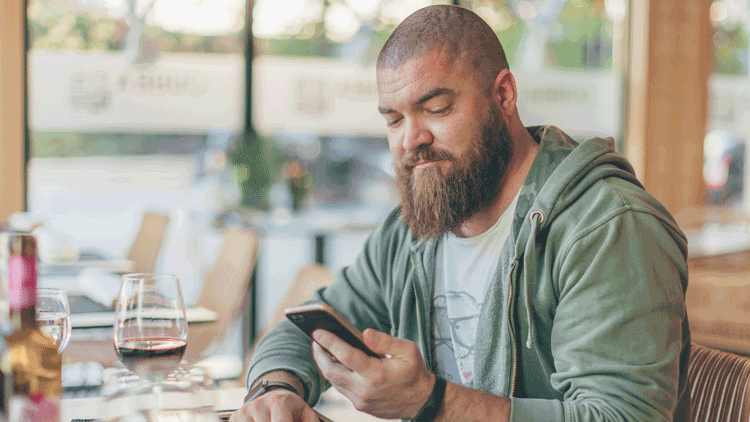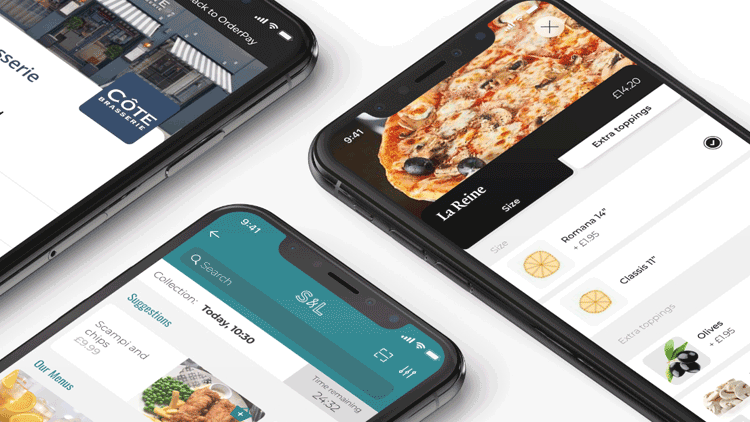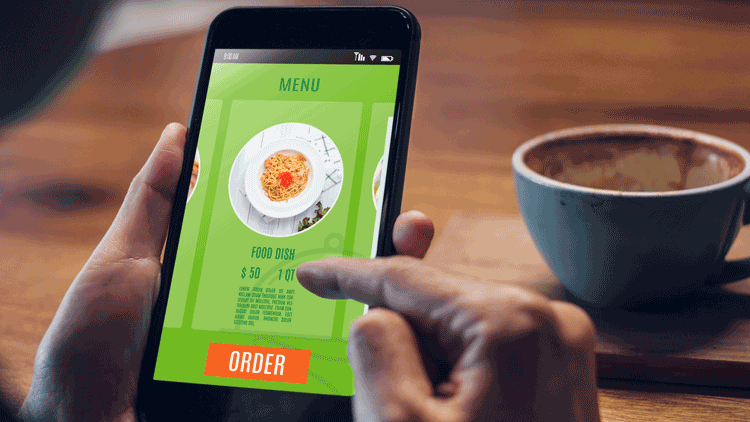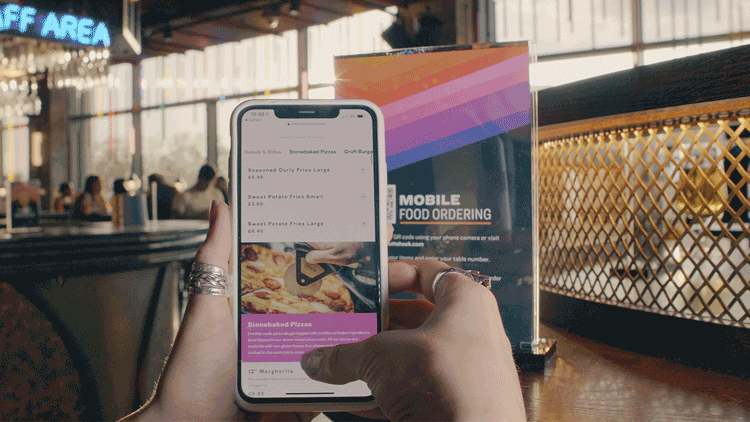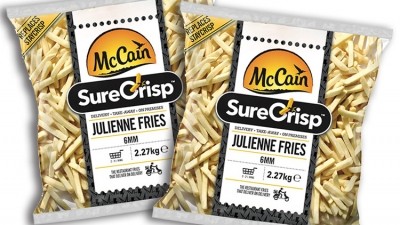How mobile order and pay tech took off
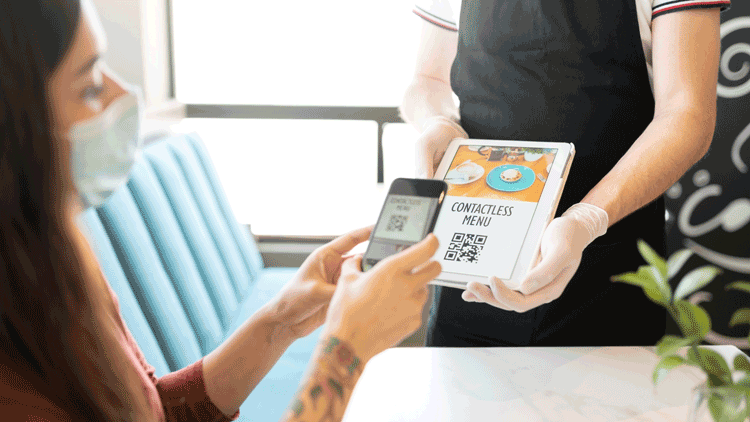
When it comes to consumer-facing technology, the restaurant sector has lagged behind others where take up has been embraced more readily. With the possible exception of McDonald’s, which successfully rolled out self-ordering kiosks across its entire estate with minimum fuss and practically no push back from customers, hospitality has sat back and watched the airline and retail industries push ahead with consumer technology while it has continued to place importance on the human interaction element of the restaurant experience.
But then came the Coronavirus pandemic and the immediate need for reduced interaction between waiting staff and guests, for minimal contact with menus and for customer details to be taken for the purpose of track and trace and mobile and ordering technology was suddenly pushed to the forefront of restaurateurs’ minds. And with it came the unlikely return of the QR code.
“The pandemic has completely propelled the demand for new hospitality tech,” says David Bull, senior marketing executive at mobile order and payment solution Yoello. “Before the pandemic, the sector was just starting to look ahead to digital innovations such as mobile ordering to improve efficiency and customer experience.
“It was mostly forward-thinking hospitality businesses that were looking to take advantage of the latest technology to get ahead, but now with Government restrictions that surround the industry, and through word of mouth as many operators are seeing the benefits to having reduced staff costs, better efficiency and higher spend per head - we’re seeing everyone from small traditional pubs to large theatres quickly turning to our technology as a necessary way to operate.”
This view is echoed by Rupert Gutteridge, chief revenue officer at contact-free order and pay platform Ordamo. “There has not been the uptake of digital menus, contactless ordering and payment in bars, restaurants and pubs because the passion is about interaction with their guests, which has caused a fairly slow adoption of this tech in hospitality sector,” he says.
“Some restaurateurs fear that if they digitise the experience will lose customers. With the airlines they all digitised at the same time, so whether people liked it or not they had to adopt it. In restaurants there has been less of this adoption. But now comes Covid, which paints a completely different picture about what hospitality is all about, which is reducing the interaction between guest and staff.
"This sort of technology facilitates offering the guest a good experience but giving them the confidence to visit a restaurant with minimal exposure to people they don’t know. The McDonald’s experience in quick service has been very successful and proves it works.”
While there is little doubt that the Coronavirus pandemic has expedited uptake of mobile ordering and payments, the hospitality sector had warmed to the idea of mobile payments, not least because of their increasingly digital-savvy clientele and the changing nature of the hospitality sector over the past few years that has made digital interaction with hospitality much more commonplace.
“There are many businesses where customers don’t feel there is value with someone coming over with a menu or a PDQ, where the better experience as a customer is to not be intruded upon,” says Wi5 CEO Prask Sutton. “Customers used to dealing with delivery aggregators are very happy to have these interactions on their mobiles if the experience is good enough.”
Sutton also says that concerns around Brexit were already making restaurants look at ways of streamlining their front of house operations in the fear that there would be a lack of staff. “There’s going to be a real lack of front of house staff available [post Brexit] and that is such a huge cost to businesses. If you can have staff focusing on other aspects of the business tech can’t do and which doesn’t mean they have to worry about taking orders of accepting payments, then that’s a real benefit.”
Benefits of mobile payments/ordering
As the pandemic continues, some of the benefits of using mobile ordering and payment systems are patently clear. At a basic level, many systems now us QR technology where customers scan a QR code to access either an individual venue or a group of venues without needing to download an app. They can then sign in for NHS track and trace purposes, order food and drink without having to wait for a member of waiting staff and pay the bill, either by credit or debit card or Apple or Google Pay, and leave without having to wait for a bill.
This lack of interaction not only meets current Covid social distancing guidelines it also helps reassure diners about the safety of eating out, which has never been more important, says Greta Glaveckaite, insights manager at Lumina Intelligence. “Cleanliness is now top of consumers’ minds,” she says, citing research Lumina conducted with Ordamo that found that seven in 10 feel an electronic menu is a much safer alternative to a paper-based one.
“The same majority also believe it is safer when ordering from own device rather than from a member of waiting staff. This kind of technology is helping to provide a safer experience need, which is growing in people’s minds.”
Mobile tech also helps speed up significantly the time a customer is required in the restaurant by eliminating the annoying delays. Speed of service is a key driver for consumers when eating out, according to Lumina data, with the time it takes to finish meal, ask for bill and be paid taking between 12 and 17 minutes. “With mobile payments this dwell time immediately disappears,” says Gutteridge. “Add in a few more interactions and you’ve got quicker turnaround of tables, more guests, more revenue for the business and better satisfaction for the guests.”
With the 10pm curfew now making restaurants watch the clock even more, speed of service, and the ability to turn tables more quickly to boost covers, has never been more crucial for the restaurant sector.
Keeping it personal
The benefits of mobile ordering extend beyond speed and efficiencies, however. Digital technology can provide a much more personalised experience, including one that could have significant ramifications in terms of health and safety. Mobile ordering allows for real-time menus, where menus are updated in real time to reflect any dishes that might be unavailable or even to change to reflect certain times of day - maybe the menu gets shorter as the 10pm curfew approaches.
According to Lumina research, 60% of consumers are willing to received personalised food offers based on their previous experiences. “Consumers are happy for their information to be used in the right way,” says Glaveckaite, “but operators have to be really strategic of how they use that data.”
“The menu is fully customisable, operators can manage everything from preferences and modifiers to dietary and allergen information so that their customer has a better ordering experience,” says Bull of Yoello’s platform. “Timed offers, bulk discounts and extras give plenty of opportunity for upselling in a non-intrusive way.”
Gutteridge also believes mobile technology can facilitate upselling. “People like to be upsold to. They like to be advised on what dishes go well together, it gives them a far richer experience.”
The issue of allergens has also come to the fore in recent years due to the tragic deaths of a number of diners who were served dishes that contained ingredients they had allergies to. Using mobile technology canhelp to overcome this, again through personalisation, with diners able to input into the platform ingredients they are allergic to which will then be flagged on the menu.
“Allergens is a growing area of importance when choosing where to eat out,” says Glaveckaite. “To be able to filter a menu based on your specific dietary needs or allergens is very useful”
Bull says with Yoello operators can manage everything from preferences and modifiers to dietary and allergen information, while mobile ordering app OrderPay says the menus for every restaurant on its platform dynamically change based on the allergens users inputted when they registered.
To app or not to app?
In the early days of mobile payments there was a prevalence for restaurants to have their own branded apps. However, with the race to create mobile ordering brought on by Covid - twinned with a growing reluctance by users to fill up their phones with numerous apps for every restaurant they might frequent - many platforms now instead use a QR code that can be scanned by the user when in a restaurant and which will then give them order and pay functionality.
“Half of consumers agree downloading an app is a barrier, solutions with QR codes are the drivers in using the technology,” says Glaveckaite, citing Lumina data. “The QR code is having a resurgence,” adds Gutteridge.
With platforms such as Yoello, Ordamo and Wi5, there is no need for an app, with customers able to scan a QR code to access either an individual venue or a group of venues. “This means instant access on any smartphone or tablet, without needing to download anything,” says Yoello’s Bull.
“A guest shouldn’t be required to download a separate app or visit a new website – or else they are more likely to abandon the order,” adds Danilo Mangano, general manager, Europe at restaurant reservation system SevenRooms. “Guest tagging can help build a deeper understanding of the diner, which can feed into personalised recommendations and bespoke offers in the future. Having the capability to up-sell – whether this is through suggesting a wine pairing with an order or additional sides a diner may wish to include, will also help drive revenue via online ordering.
However, not all new platforms take this approach, with relative newcomer OrderPay being an app that customers instead download to their phones. OrderPay chief commercial officer David Charlton describes OrderPay as a consumer-facing aggregation platform - very similar to the likes of OpenTable or Bookatable - where there are lots of restaurants on a common platform.
“The idea is to help the consumer have a consistent experience. We’ve been hearing a lot about when consumers go out to eat and each location has a different kind of ordering platform and there is very limited consistency about what they are experiencing," says Charlton. "With OrderPay they get the same experience while representing each individual restaurant brand in the way they want.”
“I hear a lot from operators about whether they should have an app or a web-based solution but being part of an app-based product means we can deliver so much more than being an ordering platform.”
OrderPay, which is now live in around 1,600 Uk venues and has more than 100,000 users signed up to the app, uses location and brand switching technology that automatically re-skins a user’s phone with a restaurant’s branding and menu on entering the venue. “The look and feel of every restaurant is very individual, they all have their own branding, styling and fonts, but the experience the customer goes through is the same,” says Charlton.
Simple platforms
What all platform providers can agree on is that a successful order and pay app is one that is simple and intuitive to use. While the early users of such technology may have been more tech-savvy Millennials, the Coronavirus pandemic now means that people of every age need to get to grips with the technology
“The most common requirement we come across with operators is finding a system that is uncomplicated in the sense that it can be easily set up without disrupting their existing system,” says Bull. “It needs to be simple for staff to get to grips with and manage and must also be as frictionless as possible from their customer’s point of view.
Wi5’s Sutton echoes this sentiment. “Some of the most important things are the most basic things that people often don’t pay enough attention to - just that it works,” he says, pointing to things such as low failure rates and EPoS integration.
“If you’re running a medium-sized business and you’re having to re-enter things into EPOS that’s not great. Systems all speaking to each other and playing nicely is super important. On the most basic level a customer comes in, places an order, that order shows up where it should, and they get what they ordered in good time. If you can do that everything else is largely just bells and whistles.”
Just as Apple phones don’t come with instruction manuals, with the user instead guided through the set-up process, platforms should be the same, says Sutton. “It has to be intuitive with no need to work it out but just follow a logical flow. That’s a huge part of it.
“The best possible scenario is that people don’t realise they are doing something new and the process is so frictionless it’s not even registering with them. The tech is not on show, people are [in a restaurant] there for the food, drink and atmosphere - if you can make the tech as forgettable as possible that’s doing a good job.”
For Mangano, a good ordering system should be about more than simply getting food to a customer. “It’s an opportunity to build a direct relationship with a guest,” he says.
“Venues need to access and capture the valuable guest data, which is paramount to building deeper relationships with diners, and providing the personalised experiences that keep them coming back. By owning this data, it allows operators to leverage their guest database in future customer interactions – whether they are dining on-premise or ordering for collection or delivery.
Sutton says security is also paramount. “As Covid hit lots of new tech solutions suddenly appeared and a lot of new suppliers saw it as an opportunity to get involved and there were many operators that hadn’t looked at the digital side of things. Some of these new businesses don’t fully understand what’s at stake and the responsibilities involved because of a lack of experience. It’s not about good intentions, you need a clear understanding of what you’re dealing with.”
Customisation is another thing operators should consider, says Nick Liddle, commercial director at technology platform Vita Mojo. “Every operator has a unique product, cost structure and a brand proposition that they have refined over many years. Being able to capture all of those nuances in a digital menu is critical. The best results come when a technology provider works closely with operations and marketing teams to implement digital systems in a way that enhances the brand proposition or product instead of compromising it.
“Vita Mojo’s digital platform is built in a way that provides operators with a lot of customisation options, to achieve the look and feel that they’re after - so that it feels like an organic part of their brand.”
A more functional future
As consumers get to grips with mobile technology and as the country moves beyond the pandemic, the scope of what such platforms can offer will broaden, with companies looking to extend their functionality. In Yoello’s case, Bull says the next big step for the company is to develop products around open banking so that it can cut out the middleman and process all payments internally. It says it is the only mobile order and pay company authorised by the Financial Conduct Authority for this and has been working on the technology to facilitate this.
“We’re currently waiting on the banks to release the required APIs this year and plan to launch this very soon. It will mean we can offer substantially cheaper transaction fees and instantaneous payments to all customers,” he says.
For Sutton, the immediate future is all about invisible payments, with customers paying for a meal as they would an Uber with payment taken in the background. “You would never go through an action of paying, which makes the experience even more slick,” he says.
Wi5 as a business also has a vision to make the hospitality sector one of greater profitability. “We are on a mission to make wafer thin profit margins a thing of the past,” says Sutton. “The pandemic has shown how so many businesses are on such tight margins.”
The company intends to do this by helping businesses use data collected from its platform to boost operational efficiencies. “We’re in the hospitality industry but we’re really a tech data-driven company. We can show restaurants how to reduce wastage and costs as well as show them consumer habits, what they do when they come in, their frequency. Are there certain things that don’t need to be on your menu, or that do but only at certain times? We want to help businesses to make the most of every customer that comes their way. Mobile ordering and pay is just an initial slice of that.”
Gutteridge, meanwhile, believes there will be a merging of platforms for much wider functionality. “There will be a merging of social media, reservations and payment into one platform that everyone is familiar with. People won’t be saying ‘have you got that contactless payment app? but ‘do you use this platform?’”
For OrderPay, the aim is to go beyond just being an ordering platform, according to Charlton. “Once we finally get out of the other side of Covid operators such as OrderPay have got to have added significant value to both restaurant groups and consumers in order for them to keep the technology in place and not go back to traditional methods of serving customers.”
The company has just introduced a tipping facility for its app, that allows people to add a tip to their bill at the end of their meal or, if they are using a system where they pay in advance of getting their food, get a prompt to tip the waiting staff once they have left the premises in the same way that users can tip an Uber driver having left the vehicle. It is also looking at providing delivery through the application in the future, which is something that other platforms such as Yoello already do.
One thing that is more novel is its digital peer to peer gifting solution that it hopes to launch before Christmas where people can send presents, such as bottle of champagne for a meal out, via the OrderPay wallet. Vouchers can be sent via Whatsapp to someone’s phone which can then be redeemed in the app.
In the longer term, Charlton envisages operators moving into what he calls omni-channel ordering, so just as they might use the services of Just Eat and Deliveroo, a restaurant business would work with multiple pay and order platforms.
Whatever the future holds, the belief is that although Covid was the catalyst for the rise in such technology, when it finally passes the tech will remain.
Before Covid, roughly 10% of business came from delivery for most restaurants, with this number rising to between 80-90% during the height of the pandemic,” says SevenRooms’ Mangano. “While there may be a natural decline as restrictions are lifted, it’s likely the demand for online ordering and the reliance on technology is here to stay.”
“The world will change a fair bit more over the next 12-18 months, but the tech is here to stay,” says Sutton. “It won’t fade as and when the current pandemic does.”
The Insider: Gavin Peters, CMO, Wi5
What one factor should you consider when choosing a mobile ordering solution?
Simplicity. Ultimately you want a solution that just works. One that's easy for customers to access instantly without any logins getting in the way, and find and pay for what they want in seconds. And one that's equally intuitive and easy for your staff.
How important is integration?
EPoS integration can offer a huge advantage in keeping things running smoothly and means menus are synched with those in the till, with all orders going to one place. At Wi5 we’ve put a huge amount of our energy into ensuring we have integrations with all the major EPOS providers that are highly reliable and quick and easy to set-up for operators, and that adding mobile Order & Pay doesn’t add any disruption to existing processes - which has been no mean feat! With mobile Order & Pay now playing such a major role in customer and staff experience, it’s vital that the technology can meet the challenge to go from being somewhat of a ‘nice-to-have’ to a seamlessly integrated part of an operators’ daily operations.
